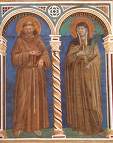
ANCREN RIWLE, a Middle English prose treatise written for a small community of three religious women and their servants at Tarent Kaines (Tarrant Crawford), at the junction of the Stour and the Tarrant, Dorset. It was generally supposed to date from the first quarter of the 13th century, but Professor E. Kolbing is inclined to place the Corpus Christi MS. about the middle of the 12th century. The house of Tarrant was founded by Ralph de Kahaines, and greatly enriched about 1230 by Richard Poor, bishop successively of Chichester, Salisbury and Durham, who was born at Tarrant and died there in 1237. At the time when the Ancren Riwle was addressed to them the anchoresses did not belong to any of the monastic orders, but the monastery was under the Cistercian rule before 1266.(1)
There are extant seven English MSS. of the work, and one Latin, the Latin version being generally supposed to be a translation. The Latin MS., Regula Anachoritarum sive de vita solitaria ( Magdalen College, Oxford, No. 67, fol. 50) has a prefatory note:-- Hic incipit prohemium venerabilis patris magistri Simonis de Gandavo, episcopi Sarum, in librum de vita solitaria, qaem scripsit sororibus suis anachoritis apud Tarente. But Bishop Simon of Ghent, who died in 1315, could not have written the book, if it dates, at latest, from the early 13th century. It has been tentatively attributed to Richard Poor, who was connected with Tarrant, and was actually a benefactor of the monastery. But the adoption of Prof. Kolbing’s early date would almost destroy Poor’s claim.
The Ancren Riwle is written in a simple, non-rhetorical style. The severity of the doctrine of self-renunciation is softened by the affectionate tone in which it is inculcated. The book contains rules for the conduct of the anchoresses, and gives liturgical directions for divine service; but the greater part of it is taken up with the purely spiritual side of religion. The rules for the restraint of the senses, for Confession and penance, are subordinated to the central idea of the supreme importance of purity of heart and the love of Christ. The last chapter deals with the domestic affairs and administration of the monastery. Incidentally the writer gives a picture of the manners and ideas of the time, and provides an account of the doctrine then generally accepted in the English church.
Ancren Riwale was edited for the Camden Society by the Rev. James Morton in 1843 from the Cotton MS. (Nero A xiv.). A collation of this text with the MS. by E. Kolbing is printed in the Jahrbuch fur romanische u. engl. Spr. und Lit. xv. 180 seq. (1876). The Ancren Riwle (ed. Abbot F. A. Gasquet, 1905) is available for the ordinary reader in The King’s Classics. There are three English MSS. of Ancren Riwle in the Cottonian collection in the British Museum, numbered Nero A xiv., Titus D xviii., and Cleopatra C vi. Nero A xiv. is written in pure south-western dialect. Portions of this text are printed in Henry Sweet’s First Middle English Primer (Oxford, 2nd ed., 1895), which contains a grammatical introduction. MS. 402 in the library of Corpus Christi College, Cambridge, contains the earliest version of Ancren Riwle, entitled Ancren Wisse, and dating (according to E. Kolbing in Englische Studien, 1886, vol. ix. 116) from about 1150. The language shows considerable traces of the Midland dialect. MS. 234 in Caius College, Cambridge, contains a considerable portion of the Ancren Riwle, but does not follow the order of the other MSS. For its exact contents see Kolbing, in Englische Studien, iii. 533 (1880). A more recently discovered version in Magdalene College, Cambridge, in MS. Pepys 2498, is entitled The Recluse, and is abridged and differently arranged. It ir written in English of the latter half of the 14th century (see A. C. Paues in Englische Studien, xxx. 344-346, 1902). A Latin version (Cotton MS. Vitellins E vii.), and a French copy (ibid. F vii.) were seriously damaged in the fire at Ashburnham House, but both MSS. have been recently restored. The Latin MS. (Codex lxvii.) at Magdalen College, Oxford, is probably a copy of another Latin text, for it contains obvious slips.
See also R. Wulker, “Uber die Sprache der Ancren Riwle und die der Homilie: Halli Meidenhad,” in Beitrage zur Geschichte der deutschen Sprache und Literatur (Halle, 1874, i. 209), giving an analysis of the differences in dialect between the two works; and Edgar Elliott Bramlette, “The Original Language of the Ancren Riwle,” in Anglia, xv. 478-498, arguing in favour of a Latin original.
*******
1 For information on the subject of Tarent Kaines see Sir W. Dugdale, Monasticon Anglicanum (new ed., 1846), vol. v. 619 et seq.
Disclosure: We are independently owned and the opinions expressed here are our own. We do have advertisements with links to other sites on our pages, and may receive compensation when you click on one of those links and/or purchase something from one of those sites.
Copyright © World Spirituality · All Rights Reserved